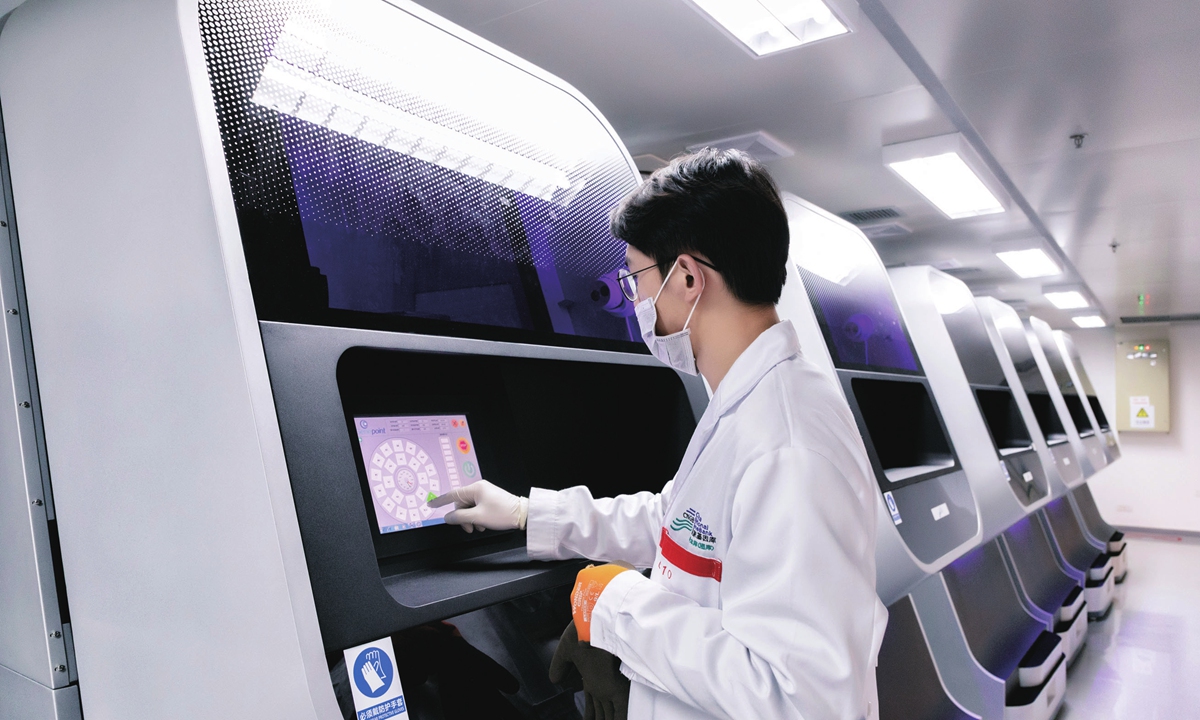With two giant statues towering over the front door and a main building in the shape of terraces, the China National GeneBank (CNGB) is no doubt an iconic landmark in Shenzhen, the rising southern Chinese metropolis that's filled with skyscrapers and is ready to emerge as a new Oriental "silicon valley" in the eyes of many.
Officially put into operation in September 2016, CNGB, China's first national integrated gene bank, was set up with the goal of preserving, digitalizing and utilizing genetic resources. Unlike other national gene banks that are normally run by government organizations, CNGB is owned by the government but operated by China's life science research institute BGI-Research.
One characteristic of China's gene bank is that it stores gene samples and genomic information covering all creatures, from microorganisms to animals and plants, Wang Ren, director-general of the CNGB, told the Global Times in an interview.
Wang stressed that CNGB also differentiated itself from other gene banks as it has an integrated ability to "read" life with a digitalization platform that offers systematic interpretation of life forms in full spectrum of the life cycle, "store" life as it preserves genes, blood, tissue, seeds as well as other biosamples, and "write" life as it leverages intervention technologies at different levels including gene, protein, cell organ and symbiotic systems.
All key equipment used for the reading, storing and writing process is also made in the country, Wang said.
So far, the CNGB has built the capacity to store tens of millions of biosamples and petabytes of multi-omics data. The China National GeneBank database (CNGBdb), a comprehensive platform for biological data sharing and application, has archived more than 4 petabytes of data for its users. Plus, the Digitalization Platform of CNGB boasts a world-leading annual data output capacity at petabase level.
"We have made some achievements with years of development. But in terms of database volume, compared with those in the US, Europe, and Japan, there is still a big gap," Wang said.

Main: A view of China National GeneBank in Shenzhen, South China’s Guangdong Province.
New seed breeding methodsAmid the central government's renewed focus on the seed breeding sector to safeguard the country's food security, CNGB, with its genomics capability that could support the development of life sciences and the bio-economy in China, is playing an increasingly vital role.
"We are helping and supporting the country's agricultural scientific research units to get out of the 'shackles' of traditional breeding methods and enter a new era of genomics breeding as soon as possible," Wang said.
Chinese policymakers have stressed quite a few times the importance of quality seeds, which are dubbed the "semiconductor microchips" of the agricultural industry. The protection, development and utilization of agricultural germplasm resources should be strengthened and the implementation of major scientific and technological projects in agricultural biological breeding should be accelerated, read the country's N0.1 document for 2021 -- the first policy statement released by China's central authorities this year.
In response to the call, the CNGB advocates a three-in-one core germplasm gene bank, the CNGB Agricultural Digital Service Platform, which will provide basic support for improving molecular breeding efficiency, increasing germplasm resources and data sharing to "turn the tables" in the seed industry.
"Nevertheless, in the crop breeding industry, if we want to make full use of current big data science and genomics technology, we still face three hurdles that needed to be crossed urgently," Wang said.
"First, we are lacking the mechanisms to share and exchange genetic resource materials and information", he said. Second, most firms still use conventional breeding methods, rather than high-throughput phenotyping platform (HT3P), which is more efficient and supported by big data. Third, breeders still have lots of room for improvement in analyzing biological information and mining and using the big-data technology.
"I am hoping that amid nationwide efforts to push forward the development of the seed industry, the government can lead the way to overcome the three hurdles," said Wang.

Inset: Biological sample resource bank at the CNBG Photo: Courtesy of CNGB
Science knows no bordersGenomics could be vital to preserve a country's bioinformatics, which is critical for future generations, while scientists and gene experts have repeatedly stressed that it is also a sector that needs global cooperation and information sharing.
In the latest project achieved under global cooperation, BGI-Research , the Centre for Genetic Resource, the Netherlands, CNGB and other institutions have carried out the entire genome re-sequencing job on 445 lettuce germplasm accessions, covering all cultivation types of lettuce, and cooperating to publish a research paper in Nature Genetics on April 12.
Through the research, the germplasm resource structure, important agronomic traits and disease resistance gene sources of lettuce have been explored and studied, providing abundant digital resources for lettuce breeding, Liu Huan, head of BGI-Research's Institute of Digital Earth BioGenome, told the Global Times.
"Sharing is one of our key responsibilities," Wang from the CNGB said, adding that the gene bank's purposes are "owned by all, completed by all and shared by all" and that could boost the world's public welfare, and availability to new technologies.
Talking about the recent uncertainties and rising sensitivity of the gene sector in the global context, Liu noted that "in the plant genetics sector and basic science, information sharing and international cooperation are still going on, which have not been interrupted due to geopolitical factors.





